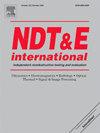Flaw sizing with plane wave imaging (PWI) – total focusing method (TFM) and deep learning for reactor pressure vessel
IF 4.1
2区 材料科学
Q1 MATERIALS SCIENCE, CHARACTERIZATION & TESTING
引用次数: 0
Abstract
Developments in machine learning and deep convolutional networks (CNNs) have enabled automated assessment of nondestructive evaluation (NDE) data. Ultrasonic data is especially challenging for automated evaluation due to its complexity, multi-channel nature, and volume. Typical flaw signals have low signal to noise ratio, particularly diffraction signals critical for sizing. This study presents a proof-of-concept on the application of deep CNNs, specifically U-net and Swin-U-net, for flaw sizing in ultrasonic data from a nuclear test block with realistic flaw simulations. The segmentation CNNs extract flaw signals, enabling the identification of the deepest crack tip echo, mimicking human inspection. This mimics the process used by human inspectors. Two distinct CNNs are trained: U-net and a transformer-based Swin-U-net. A novel data reconstruction method is proposed that combines plane wave imaging (PWI), synthetic aperture focusing (SAFT) and total focusing method (TFM) to provide a unified volume reconstructed view. Both networks provide good segmentation performance allowing accurate sizing, despite noisy data and complex flaw signals.
求助全文
约1分钟内获得全文
求助全文
来源期刊

Ndt & E International
工程技术-材料科学:表征与测试
CiteScore
7.20
自引率
9.50%
发文量
121
审稿时长
55 days
期刊介绍:
NDT&E international publishes peer-reviewed results of original research and development in all categories of the fields of nondestructive testing and evaluation including ultrasonics, electromagnetics, radiography, optical and thermal methods. In addition to traditional NDE topics, the emerging technology area of inspection of civil structures and materials is also emphasized. The journal publishes original papers on research and development of new inspection techniques and methods, as well as on novel and innovative applications of established methods. Papers on NDE sensors and their applications both for inspection and process control, as well as papers describing novel NDE systems for structural health monitoring and their performance in industrial settings are also considered. Other regular features include international news, new equipment and a calendar of forthcoming worldwide meetings. This journal is listed in Current Contents.
 求助内容:
求助内容: 应助结果提醒方式:
应助结果提醒方式:


